- Home
- Michael Crichton
Travels Page 2
Travels Read online
Page 2
We had a white female, but she was thin, and very old. The hands and feet were wrapped. It wasn’t as bad as I had imagined, although the smell of phenol preservative was strong.
Our instructor told us we would begin the dissection with two people on each side of the body. We would begin on the leg. We could start cutting now.
Nobody moved.
Everybody looked at one another. The instructor said that we would have to work quickly and steadily if we hoped to keep on schedule and finish the dissection in three months.
Then, finally, we began to cut.
The skin was cold, gray-yellow, slightly damp. I made my first cut with a scalpel, slitting across the area where the thigh meets the body, and then straight down the leg to the knee. I didn’t cut deeply enough the first time. I barely nicked the skin.
“No, no,” said my instructor. “Cut.”
I cut again, and the flesh opened, and we began scraping away the skin from the underlying tissue. That was when we began to realize that dissection was hard work, both meticulous and strenuous. You did most of it with the blunt end of a pair of scissors. Or with your fingers.
As the skin spread apart, what we first saw was the fat—a broad expanse of yellowish tissue surrounding everything we wanted to see. In the heat, the fat was slippery and runny. When we stripped away this layer, we found the muscles, enclosed in a milky, cellophane-like covering. This was the fascia. It was strong and resilient; we had trouble cutting through it to the muscle beneath. The muscles looked like what you’d expect: reddish, striated, bulging in the middle and tapering at the ends. The arteries were easy: they’d been injected with red latex. But we had no idea what the nerves looked like until the instructor came over and found one for us—white, tough, cord-like.
The afternoon wore on, and took on aspects of a nightmare: everybody working, sweat dripping down our faces; the smell, pungent and indescribable; the unwillingness to wipe the sweat away because you’d only coat your face with phenol; the sudden horrified discovery that a bit of flesh has been flicked away and landed, sticking, to your face; the ghastly drabness of the room itself, bare, hot, institutional gray. It was a cheerless, exhausting experience.
Just the names we had to learn were difficult enough: superficial epigastric artery, superficial external pudendal artery, pectineal fascia, anterior superior iliac spine, ligamentum patellae. All in all, forty different structures that had to be memorized for the first day alone.
We worked until five, and then sutured the incision, squirted liquid over it to keep it moist, and left. We hadn’t managed to finish the dissection, as outlined in the lab manual.
At the end of the first day, we were already behind.
Nobody could eat much at dinner. The second-year students regarded us with amusement, but we weren’t making many jokes in the early days. We were all struggling too hard to handle the feelings, to do it at all.
The autumn heat wave continued, and the dissection room became extremely hot. The fat deposits melted; smells were strong; everything was greasy to the touch. Sometimes the doorknob was so greasy that we had trouble turning it when we departed at the end of the day. Even when maggots got into one cadaver, causing the instructors to run around the room with flyswatters, nobody made jokes.
It was hard work. We were just trying to do it.
The weeks passed. The heat wave continued. We were under terrific pressure to keep pace with the dissection, not to fall behind. The first anatomy exams were getting closer. Two afternoons a week, we worked in the dissection rooms. And again on weekends, if we had to catch up. We began to make sour, grim jokes.
One joke made the rounds:
A professor of anatomy addresses a woman in the class: “Miss Jones, will you name the organ of the body that increases four times in diameter under stimulation?”
The woman becomes embarrassed, hems and haws.
“There’s no need to be embarrassed, Miss Jones. The organ is the pupil of the eye—and you, my dear, are an optimist.”
After the first anatomy exam, I got a letter in the mail:
Dear Mr. Crichton:
Although your performance on the recent Gross Anatomy exam was satisfactory, you were sufficiently close to the borderline that it will be to your advantage to talk to me sometime in the near future, at your convenience.
Yours sincerely,
George Erikson,
Professor of Anatomy
Panic. A cold sweat. I was shaken. Then at lunch I discovered that lots of other people had received letters, too. In fact, almost half the class. I went to see Dr. Erikson that afternoon. He didn’t say much; just some encouragement, some hints on memorization. Talk to yourself, he said. Say things out loud. Pair up and quiz each other.
Pretty soon everyone in the anatomy lab was talking out loud, repeating mnemonics to help them remember.
“S 2, 3, 4, keeps your rectum off the floor.” That told you where the nerves to the levator-ani muscle originate, in the second, third, and fourth sacral segments.
“Saint George Street.” For the order of muscles inserting around the knee.
“The Zebra Bit My Cock.” For the branches of the facial nerve: temporal, zygomatic, buccal, mandibular, cervical.
My lab partner developed a new one: “TE, TE, ON, OM.” Two eyes, two ears, one nose, one mouth.
They quizzed us constantly, calling us “Doctor” even though we were first-year students. One instructor came in and threw up an X-ray of a skull. I’d never seen one before. A skull X-ray is incredibly complex.
“All right, Dr. Crichton, what would you say this is?”
He pointed to a whitish area on the film. It was near the face, and horizontal.
“The hard palate?”
“No, that’s down here.” He pointed to another horizontal line, a little below.
I tried again, and suddenly it came to me: “The inferior border of the orbit.”
“Right.”
It was a great feeling.
Then he said, “How about this?” A small, hook-shaped thing near the middle of the skull.
That was easy. “The sella turcica.”
“Containing?”
“The pituitary.”
“What is just lateral to it?”
“The cavernous sinus.”
“Containing?”
I rattled it off: “The curving internal carotid artery, and the ocular nerves, three, four, and six, and two branches of the trigeminal nerve, the ophthalmic and the maxillary.”
“And this dark space, just below?”
“The sphenoid sinus.”
“And why is it dark?”
“Because it contains air.”
“Right. Now then, Dr. Martin …” And he turned to another member of the group.
I thought, I’m getting it. I’m finally beginning to get it. I was excited. But at the same time, the pressure was building. Every day, building.
The jokes got worse. One guy wrote “Al’s Body Shop” on the back of his anatomy lab coat. And the cadavers began getting names: The Jolly Green Giant, The Thin Man, King Kong.
Ours had a name, too: Lady Brett.
After two months, on a day when the instructors were out of the room, several people played football with a liver. “He’s going out, he’s deep in the end zone, the ball is in the air … and … touchdown!” The liver flew through the air.
A few students pretended to be horrified, but nobody really was. We had by now dissected the legs, and the feet had been unwrapped; we had dissected the arms, the hands, and abdomen. We could see that this was a human body, a dead person laid out on the table before us. We were continuously reminded of what we were doing—we could see the form clearly. There was no way to get the necessary distance, to detach, except to be outrageous and disrespectful. There was no way to survive except to laugh.
There were certain jobs in the dissection that nobody wanted to do. Nobody wanted to cut the pelvis in half. Nobody wanted to dissect
the face. Nobody wanted to inflate the eyeballs with a syringe. We portioned out these jobs, argued over them.
I managed to avoid each of these jobs.
“Okay, Crichton, but then you have to section the head.”
“Okay.”
“You remember, now.…”
“Yeah, yeah, I’ll remember.”
The head was in the future. I’d worry about it when I got there.
* * *
But the day finally came. They handed me the hacksaw. I realized I had made a terrible bargain. I had waited, and now I was stuck with the most overt mutilation of all, to divide the head along the midsagittal plane, to cut it in half like a melon so we could see inside, inspect the cavities, the sinuses, the passages, the vessels.
The eyes were inflated, staring at me as I cut. We had dissected the muscles around the eyes, so I couldn’t close them. I just had to go through with it, and try to do it correctly.
Somewhere inside me, there was a kind of click, a shutting off, a refusal to acknowledge, in ordinary human terms, what I was doing. After that click, I was all right. I cut well. Mine was the best section in the class. People came around to admire the job I had done, because I had stayed exactly in the midline and all the sinuses were beautifully revealed.
I later learned that this shutting-off click was essential to becoming a doctor. You could not function if you were overwhelmed by what was happening. In fact, I was all too easily overwhelmed. I tended to faint—when I saw accident victims in the emergency ward, during surgery, or while drawing blood. I had to find a way to guard against what I felt.
And still later I learned that the best doctors found a middle position where they were neither overwhelmed by their feelings nor estranged from them. That was the most difficult position of all, and the precise balance—neither too detached nor too caring—was something few learned.
At the time I resented the fact that our education seemed to be as much about emotions as about the factual content of what we were learning. This emotional aspect seemed more like hazing, like a professional initiation, than education. It was a long time before I understood that how a doctor behaved was at least as important as what he knew. And certainly I did not suspect that my complaints about medicine would eventually focus almost entirely on the emotional attitudes of the practitioners, and not their scientific knowledge.
A Good Story
The first part of a student’s clinical work involves interviewing patients with various diseases. The resident on the floor says, “Go see Mr. Jones in room five, he has a good story”—meaning that Mr. Jones can give a clear history for a specific disease. Off you go to find Mr. Jones, take his history, and diagnose his illness.
For a student beginning work in a hospital, there is considerable tension in interviewing patients. You’re trying to act professional, as if you know what you’re doing. You’re trying to make the diagnosis. You’re trying not to forget all the things you’re supposed to ask, all the things you’re supposed to check, including incidental findings. Because you don’t want to come back to the resident and say, “Mr. Jones has a peptic ulcer,” only to have the resident say, “That’s true. But what about his eyes?”
“His eyes?”
“Yes.”
“His eyes, hmmm …”
“Did you check his eyes?”
“Uh … sure. Yes.”
“Notice anything about them?”
“No …”
“You didn’t notice his left eye is glass?”
“Oh. That.”
To avoid these embarrassments, and to make the job easier, all students quickly learned certain interviewing tricks. The first trick was to get someone to tell you the diagnosis, so you wouldn’t have to figure it out for yourself. Knowing the diagnosis took a lot of the pressure off an interview. If you were especially lucky, the resident himself would let it slip: “Go see Mr. Jones in room five; he has a good story of peptic ulcer.”
Or you could throw yourself on the mercy of the nurses:
“Where’s Mr. Jones?”
“Peptic ulcer? Room five.”
Then there might be relatives in the room when you arrived. They were always worth a try. “Hello, Mrs. Jones. How are you today?”
“Fine, Doctor. I was just talking with my husband about his new ulcer diet when he goes home.”
And, finally, the patients generally knew their diagnoses, and they might mention it, particularly if you walked in, sat down, and said heartily, “Well, how’re you feeling today, Mr. Jones?”
“Much better today.”
“What have the doctors told you about your illness?”
“Just that it’s a peptic ulcer.”
But even if the patients didn’t know their diagnoses, in a teaching hospital they had all been interviewed so many times before that you could tell how you were doing by watching their responses. If you were on the right track, they’d sigh and say, “Everybody asks me about pain after meals,” or “Everybody asks me about the color of my stools.” But if you were off track, they’d complain, “Why are you asking me this? Nobody else has asked this.” So you often had the sense of following a well-worn path.
But even if you figured out the diagnosis, there was always an exciting uncertainty about interviewing patients. You never knew what would happen. One day the resident said, “Go see Mrs. Willis, room eight; she has a good story of hyperthyroidism.”
I walked down the hallway, thinking, Hyperthyroidism, hyperthyroidism, what do I know about hyperthyroidism?
Mrs. Willis was a thin thirty-nine-year-old woman, sitting up in bed, chain-smoking. Her eyes were bulging. She was edgy and appeared unhappy. Her dark tan highlighted the many slashing scars on her arms and face, presumably the result of a bad automobile accident.
I introduced myself and started to talk to her, focusing on thyroid questions. The thyroid regulates general body metabolism and it affects skin, hair, voice, temperature, weight, energy, and mood. Mrs. Willis gave me all the right answers. She couldn’t gain weight no matter how much she ate. She was always hot and slept with the covers off. She had noticed that her hair was brittle. Yes, yes, yes, everybody had asked her these things. She was quick and impatient in her responses. She often seemed on the verge of tears.
I asked her about her suntan. She told me she had been staying with her sister in Alabama. It was all right because her sister’s apartment was air-conditioned. She had been with her sister in Alabama for three months. Now she was back in Boston.
Why was she in the hospital?
“For my thyroid, it’s too high.”
What had brought her to the hospital?
A shrug. “I came and they said I had to stay. Because of my thyroid.”
“How did you get the scars on your arms?”
“Those’re cuts.”
“Cuts?”
“From a knife, most of them. This one here’s glass.”
The scars seemed to be of different ages, some recent, some older.
“Yes. This one is about five years old, the others are newer.”
“How did they happen?”
“My husband.”
“Your husband?” I proceeded cautiously. She seemed close to tears now.
“He cuts me. When he’s, you know, drinking.”
“How long has this been going on, Mrs. Willis?”
“I told you: five years.”
“Is that why you went to your sister’s?”
“She says I should call the police.”
“And have you?”
“Once. They didn’t do anything. They came and told him to stop it, is all. He was mad after that.”
And she burst into great sobs, her whole body shaking, tears streaming down her face.
I was confused. Emotional lability is characteristic of hyperthyroidism; patients frequently burst into tears. But this woman appeared to have been seriously abused by her husband. I talked to her some more. She had initially come to the hospita
l because of her wounds. The doctors had admitted her for hyperthyroidism, but that was clearly an excuse to get her away from her violent husband. She was safe enough in the hospital, but what would happen once she was discharged?
“Has anybody talked to you about your husband? A social worker or anybody like that?”
“No.”
“Do you want somebody to talk to about your husband?”
“Yes.”
I said I would arrange it, and I left, filled with outrage.
In those days, physical abuse within a family was not really acknowledged. Everyone pretended that wives and children weren’t beaten. There were no laws, no government agencies, no homes, no mechanisms at all to assist these people. I felt strongly the injustice of this situation, and this woman’s dangerous isolation—sitting alone in a hospital bed, waiting to be sent home to her husband, who would stab her again.
Nobody was doing anything about it. The doctors might be treating her thyroid, but nobody was dealing with the real, life-threatening problems she faced.
I went back to the resident.
“Listen, did you see Mrs. Willis’s wounds?”
“Yes.”
“Those are knife wounds.”
“Yes. Some of them.” He seemed calm.
“Well, here we are treating her hyperthyroidism and it seems to me she has a much bigger problem.”
“All we can treat is her hyperthyroidism,” the resident said.
“I think we can do more. We can take steps to keep her away from her husband.”
“What husband?”
“Mrs. Willis’s husband.”
“She doesn’t have a husband. What did she tell you?”
I told him the story.
“Listen,” he said, “Mrs. Willis was transferred here from a private sanatorium in Alabama. Her family is well-to-do, but her husband divorced her years ago. She’s been in and out of institutions for a decade. All those cuts are self-inflicted.”
“Oh.”
The resident said, “Did you ask her whether she’d ever been in any mental institutions?”

 Dragon Teeth
Dragon Teeth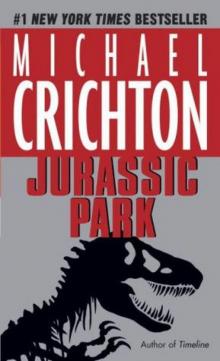 Jurassic Park
Jurassic Park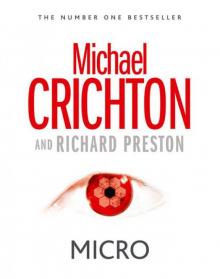 Micro
Micro The Great Train Robbery
The Great Train Robbery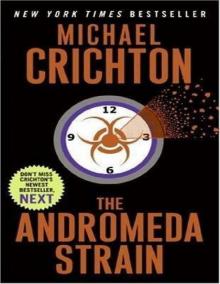 The Andromeda Strain
The Andromeda Strain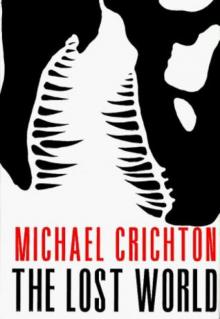 The Lost World
The Lost World Congo
Congo Travels
Travels Timeline
Timeline Sphere
Sphere Westworld
Westworld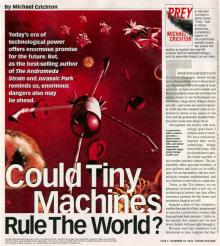 Prey
Prey State Of Fear
State Of Fear Next
Next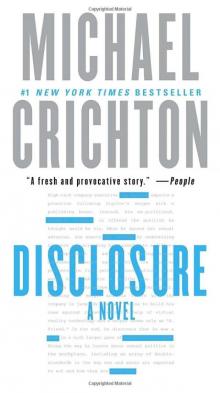 Disclosure
Disclosure Pirate Latitudes
Pirate Latitudes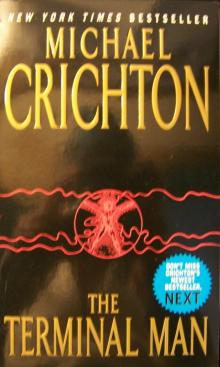 The Terminal Man
The Terminal Man Five Patients
Five Patients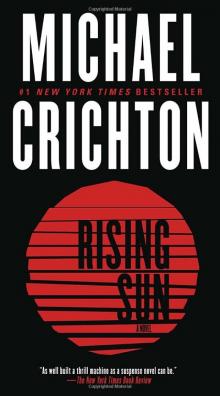 Rising Sun
Rising Sun Binary
Binary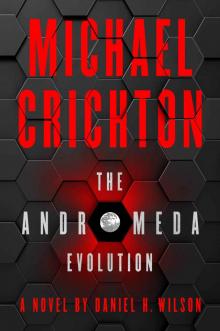 The Andromeda Evolution
The Andromeda Evolution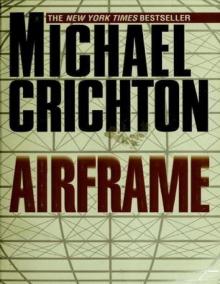 Airframe
Airframe Easy Go
Easy Go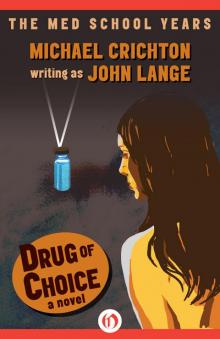 Drug of Choice
Drug of Choice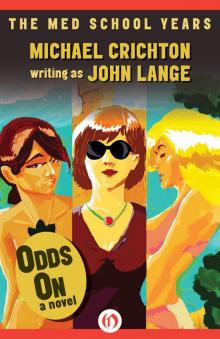 Odds On: A Novel
Odds On: A Novel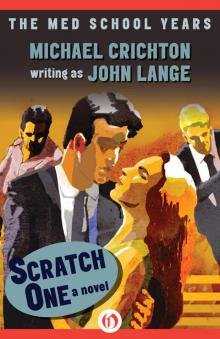 Scratch One
Scratch One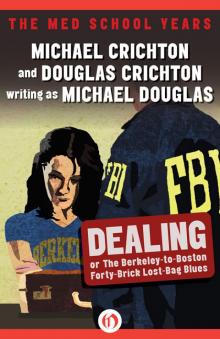 Dealing or The Berkeley-to-Boston Forty-Brick Lost-Bag Blues
Dealing or The Berkeley-to-Boston Forty-Brick Lost-Bag Blues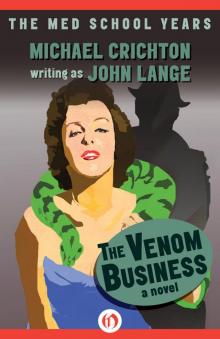 Venom Business
Venom Business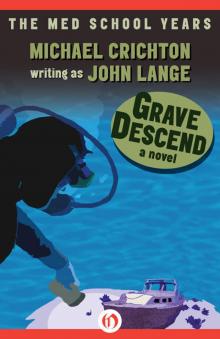 Grave Descend
Grave Descend Gold - Pirate Latitudes
Gold - Pirate Latitudes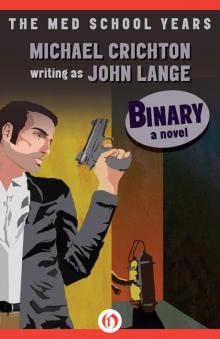 Binary: A Novel
Binary: A Novel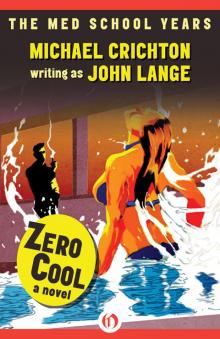 Zero Cool
Zero Cool Delos 1 - Westworld
Delos 1 - Westworld